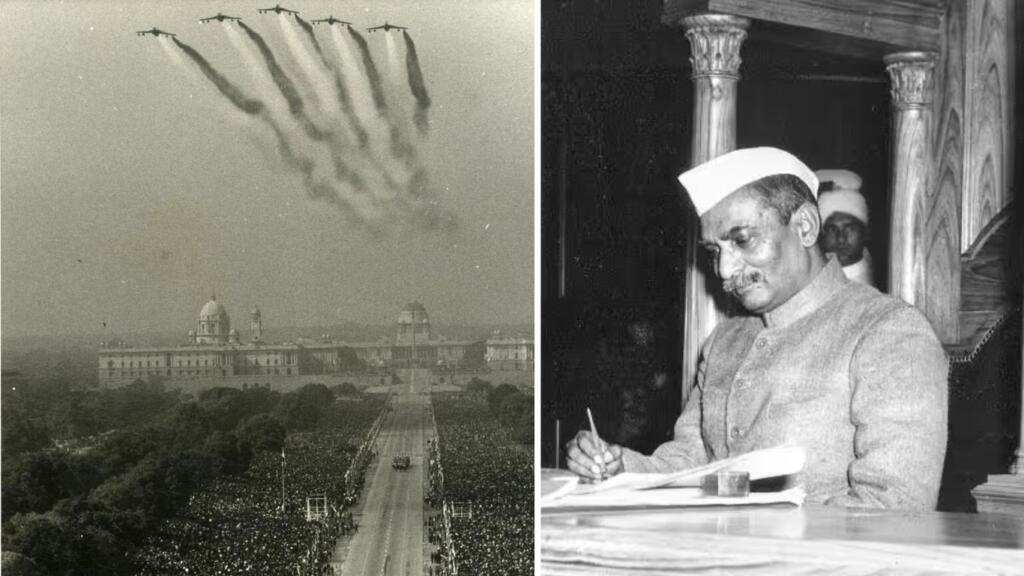India and Indians are all set to celebrate the 76th Republic Day tomorrow January 26. Where all kinds of exhibitions, parades and Air moves by the Indian Airforce will be shown to the world. However, the new generation of Indians should know how the first Republic Day was celebrated and what all happened on January 26 1950.
Looking into the past has always been fascinating for the human race, the article will take you 75 years back to the black-and-white era of a newborn nation.
Let’s begin..
The first Republic Day celebration of India on January 26, 1950, was an event of immense historical significance and unmatched enthusiasm. It marked the beginning of a new era in Indian history, with Dr Rajendra Prasad taking the oath as the first President of the Republic of India. People celebrated this historic day by cracking firecrackers and singing folk songs.
The Swearing-in Ceremony
The day began with a simple yet grand swearing-in ceremony held at the Durbar Hall of Government House. At 10:30 am, a 21-gun salute, using artillery field guns (25-pounder howitzers), typically of British origin, as these were the primary weapons available to the Indian Army at the time, heralded the birth of the Republic. Mr. C. Rajagopalachari, the retiring Governor-General of India, read out the proclamation of the Republic, officially declaring India, “that is, Bharat,” a sovereign nation. Just after 6 minutes, Dr Rajendra Prasad then took the oath of office and delivered a brief speech in Hindi and English, expressing hope for a united and prosperous India.
The speech goes like this….
“Today for the first time in our long and chequered history we find the whole of this vast land from Kashmir in the North to Cape Comorin in the South, from Kathiawad and Cutch in the West to Coconada and Kamrup in the East, brought together under the jurisdiction of one Constitution and one Union which takes over the responsibility for the welfare of more than 320 million men and women that inhabit it. Its administration will now be carried on by its people and for its people. This country has great natural resources, and now has come to it the great opportunity to make its vast population happy and prosperous and to make its own contribution to the establishment of peace in the world.”
The State Drive
At 2:30 pm, the newly sworn-in President embarked on a ceremonial state drive from Government House to Irwin Stadium (Major Dhyan Chand National Stadium). He travelled in a 35-year-old coach, refurbished for the occasion, bearing the new emblem of Ashoka’s Lion Capital. The coach was drawn by six Australian horses and escorted by the President’s Bodyguard.
The route was lined with hundreds of thousands of enthusiastic citizens, who shouted “Jai” and cheered as the President passed by. People occupied every available spot—from rooftops to treetops—to catch a glimpse of the historic procession. The President acknowledged the crowd’s greetings with folded hands, embodying humility and respect.
The Parade at Irwin Stadium (Major Dhyan Chand National Stadium)
The state drive concluded at Irwin Stadium (Major Dhyan Chand National Stadium) at 3:45 pm, where a spectacular ceremonial parade awaited. The parade featured 3,000 personnel from the Army, Navy, Air Force, Police, and other service contingents. More than 100 aircraft were part of the beautiful fly-past. Around 15,000 spectators witnessed this magnificent display of military might and discipline.
The President, standing in an Army jeep and accompanied by Brigadier J.S. Dhillon, inspected the parade. Units of the Navy, Infantry, Cavalry Regiments, and Boys’ Units of the Punjab Regiment participated in the march-past, showcasing their precision and coordination. The crowd’s cheers echoed as they admired the soldiers’ discipline and colourful uniforms.
Seven massed bands (Indian Navy Band, Indian Army Band, Indian Air Force Band, Cavalry Regiment Band, Infantry Regiment Band, Punjab Regiment Boys’ Band and Police Band) representing the armed forces and police provided stirring music, adding to the grandeur of the event. One of the most memorable moments was the firing of “feu-de-joie,” (French for “fire of joy”) a ceremonial gunfire display, synchronized with the playing of the National Anthem. Simultaneously, cannons fired a salute to the President, symbolizing the authority and pride of the new Republic.
Also Read: 76th Republic Day: Navy’s female Agniveers take center stage
Nationwide Celebrations
Celebrations were not confined to Delhi alone. Across the country, millions of Indians participated in festivities, and the proclamation of the Republic was read out in all states of the Indian Union. Indias sang their folk songs and celebrated by firing crackers at night. Indians living abroad also celebrated the occasion with great enthusiasm, showcasing their pride in their homeland. Messages of goodwill poured in from heads of state around the world, reflecting global acknowledgement of India’s historic transformation.
Significance
The first Republic Day celebrations captured the spirit of unity, hope, and national pride. The event not only highlighted the cultural and military strength of India but also symbolized the beginning of self-governance under a democratic Constitution. It remains etched in the memory of the nation as a day when India truly embraced its identity as a sovereign republic.
Let us know if you have heard any story of the first Republic Day celebration through your grandparents or freedom fighters living around in comment. It will excite us and other readers to read and enjoy our collective past.
